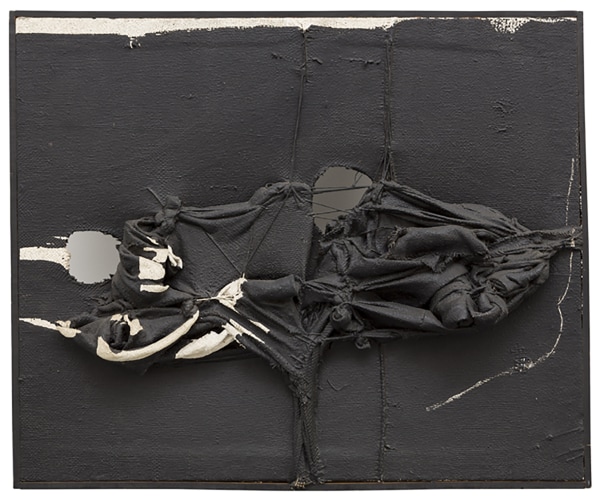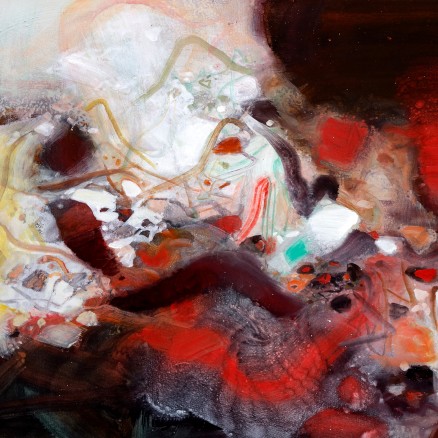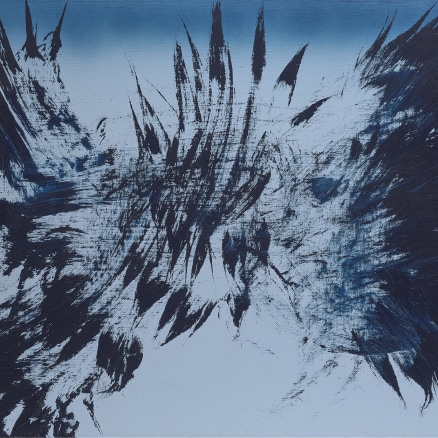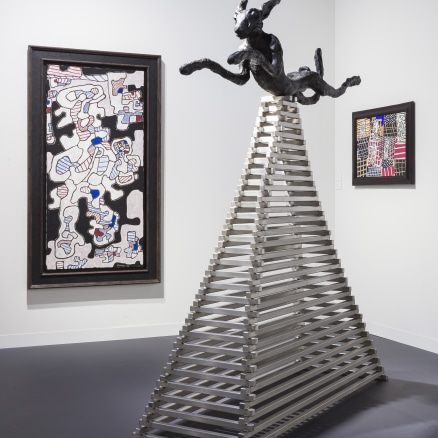Biography
Manolo Millares (b. 1926, Las Palmas, Canary Islands; d. 1972, Madrid, Spain), an important post-war Spanish painter, is renowned for his dramatic ‘collages’ created using burlap sackcloth. The burlap, sometimes bare, was stretched taut, pieces sewn roughly together to create tears and voids. His vital, gestural paintwork, in sombre tones, black, white and red, spattered and dripped across the surface. First produced in 1953, the burlap works were deeply rooted in the pre-history of the Canary Islands, in particular that of the aboriginal inhabitants, the Guanches. Embalmed corpses of this pre-Hispanic people were known to him from the extensive displays housed in the Museo Canario in Las Palmas. In 1955, Millares moved to Madrid where he became friends with Antonio Saura, and they formed the core of a new avant-garde movement, El Paso. With Saura and artists such as Pablo Serrano, Manuel Rivera, Rafael Canogar and Luis Feito, he sought a new aesthetic, relevant to the post-war era. With a moral imperative, he made direct reference to long-disappeared civilisations, overcome and assimilated. Millares is associated with the Informalist movement, which emphasised formal experimentation and political engagement, and is considered to be largely responsible for the renaissance in modern Spanish art. He developed his own visual language inspired by petrograms left by the Guanches, whose organic forms painted on cave walls he reconciled with the automatism of the Surrealists. Millares combined tradition with direct expression, pre-history and contemporary.
The 1957 Ateneo de Madrid exhibition of his burlap paintings and his inclusion in the Venice Biennial that same year brought international recognition and dealers Pierre Matisse and Daniel Cordier signed agreements with him in 1959. In 1960, Millares had his first solo exhibition at the Pierre Matisse Gallery, New York. He participated in the European Art Today: 35 Painters and Sculptors exhibition at the Minneapolis Institute of Arts, in 1959, and in Before Picasso: After Miró at the Solomon R. Guggenheim Museum, New York (1960). Millares’s work was included in group exhibitions in the United States throughout his lifetime. In 1970, Millares produced a film about his life and work, filmed by his wife Elvireta Escobio, that showed footage interspersed with images of war, fascism and desolate landscapes. Posthumous exhibitions have been held at Pierre Matisse Gallery, New York (1974), Museo Nacional Centro de Arte Reina Sofía, Madrid (1992), and the Sen-oku Hakuko Kan Museum, Tokyo (2003). In 2004, Alfonso de la Torre’s catalogue raisonné of Millares’s paintings was published by Fundacion Azcona and Museo Nacional Centro de Arte Reina Sofía.
Read more
Works
-
 Manolo Millares, Cuadro (10), 1964
mixed media on burlap
62.5 x 75.5 cm
%3Cdiv%20class%3D%22artist%22%3E%3Cspan%20class%3D%22artist%22%3E%3Cstrong%3EManolo%20Millares%3C/strong%3E%3C/span%3E%3C/div%3E%0D%3Cdiv%20class%3D%22title%22%3E%3Cem%3ECuadro%20%2810%29%3C/em%3E%2C%201964%3C/div%3E%0D%3Cdiv%20class%3D%22medium%22%3Emixed%20media%20on%20burlap%3C/div%3E%0D%3Cdiv%20class%3D%22dimensions%22%3E%2062.5%20x%2075.5%20cm%3C/div%3E
Manolo Millares, Cuadro (10), 1964
mixed media on burlap
62.5 x 75.5 cm
%3Cdiv%20class%3D%22artist%22%3E%3Cspan%20class%3D%22artist%22%3E%3Cstrong%3EManolo%20Millares%3C/strong%3E%3C/span%3E%3C/div%3E%0D%3Cdiv%20class%3D%22title%22%3E%3Cem%3ECuadro%20%2810%29%3C/em%3E%2C%201964%3C/div%3E%0D%3Cdiv%20class%3D%22medium%22%3Emixed%20media%20on%20burlap%3C/div%3E%0D%3Cdiv%20class%3D%22dimensions%22%3E%2062.5%20x%2075.5%20cm%3C/div%3E -
 Manolo Millares, Cuadro 113, 1960
mixed media on burlap
100 x 81 cm
%3Cdiv%20class%3D%22artist%22%3E%3Cspan%20class%3D%22artist%22%3E%3Cstrong%3EManolo%20Millares%3C/strong%3E%3C/span%3E%3C/div%3E%0D%3Cdiv%20class%3D%22title%22%3E%3Cem%3ECuadro%20113%3C/em%3E%2C%201960%3C/div%3E%0D%3Cdiv%20class%3D%22medium%22%3Emixed%20media%20on%20burlap%3C/div%3E%0D%3Cdiv%20class%3D%22dimensions%22%3E100%20x%2081%20cm%3C/div%3E
Manolo Millares, Cuadro 113, 1960
mixed media on burlap
100 x 81 cm
%3Cdiv%20class%3D%22artist%22%3E%3Cspan%20class%3D%22artist%22%3E%3Cstrong%3EManolo%20Millares%3C/strong%3E%3C/span%3E%3C/div%3E%0D%3Cdiv%20class%3D%22title%22%3E%3Cem%3ECuadro%20113%3C/em%3E%2C%201960%3C/div%3E%0D%3Cdiv%20class%3D%22medium%22%3Emixed%20media%20on%20burlap%3C/div%3E%0D%3Cdiv%20class%3D%22dimensions%22%3E100%20x%2081%20cm%3C/div%3E -
 Manolo Millares, Cuadro 18 (1), 1957
mixed media on burlap
39 3/8 x 59 in / 100 x 150 cm
%3Cdiv%20class%3D%22artist%22%3E%3Cspan%20class%3D%22artist%22%3E%3Cstrong%3EManolo%20Millares%3C/strong%3E%3C/span%3E%3C/div%3E%0D%3Cdiv%20class%3D%22title%22%3E%3Cem%3ECuadro%2018%20%281%29%3C/em%3E%2C%201957%3C/div%3E%0D%3Cdiv%20class%3D%22medium%22%3Emixed%20media%20on%20burlap%3Cbr%20/%3E%0A%3C/div%3E%0D%3Cdiv%20class%3D%22dimensions%22%3E39%203/8%20x%2059%20in%20/%20100%20x%20150%20cm%3C/div%3E
Manolo Millares, Cuadro 18 (1), 1957
mixed media on burlap
39 3/8 x 59 in / 100 x 150 cm
%3Cdiv%20class%3D%22artist%22%3E%3Cspan%20class%3D%22artist%22%3E%3Cstrong%3EManolo%20Millares%3C/strong%3E%3C/span%3E%3C/div%3E%0D%3Cdiv%20class%3D%22title%22%3E%3Cem%3ECuadro%2018%20%281%29%3C/em%3E%2C%201957%3C/div%3E%0D%3Cdiv%20class%3D%22medium%22%3Emixed%20media%20on%20burlap%3Cbr%20/%3E%0A%3C/div%3E%0D%3Cdiv%20class%3D%22dimensions%22%3E39%203/8%20x%2059%20in%20/%20100%20x%20150%20cm%3C/div%3E




















